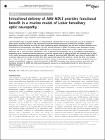| dc.contributor.author | CAMPBELL, MATTHEW | en |
| dc.contributor.author | FARRAR, JANE | en |
| dc.contributor.author | KENNA, PAUL | en |
| dc.date.accessioned | 2015-01-06T10:35:40Z | |
| dc.date.available | 2015-01-06T10:35:40Z | |
| dc.date.issued | 2013 | en |
| dc.date.submitted | 2013 | en |
| dc.identifier.citation | Chadderton N, Palfi A, Millington-Ward S, Gobbo O, Overlack N, Carrigan M, O'Reilly M, Campbell M, Ehrhardt C, Wolfrum U, Humphries P, Kenna PF, Jane Farrar G, Intravitreal delivery of AAV-NDI1 provides functional benefit in a murine model of Leber hereditary optic neuropathy., European journal of human genetics : EJHG, 21, 1, 2013, 62-8 | en |
| dc.identifier.other | Y | en |
| dc.identifier.uri | http://hdl.handle.net/2262/72916 | |
| dc.description | PUBLISHED | en |
| dc.description.abstract | Leber hereditary optic neuropathy (LHON) is a mitochondrially inherited form of visual dysfunction caused by mutations in several genes encoding subunits of the mitochondrial respiratory NADH-ubiquinone oxidoreductase complex (complex I). Development of gene therapies for LHON has been impeded by genetic heterogeneity and the need to deliver therapies to the mitochondria of retinal ganglion cells (RGCs), the cells primarily affected in LHON. The therapy under development entails intraocular injection of a nuclear yeast gene NADH-quinone oxidoreductase (NDI1) that encodes a single subunit complex I equivalent and as such is mutation independent. NDI1 is imported into mitochondria due to an endogenous mitochondrial localisation signal. Intravitreal injection represents a clinically relevant route of delivery to RGCs not previously used for NDI1. In this study, recombinant adenoassociated virus (AAV) serotype 2 expressing NDI1 (AAV-NDI1) was shown to protect RGCs in a rotenone-induced murine model of LHON. AAV-NDI1 significantly reduced RGC death by 1.5-fold and optic nerve atrophy by 1.4-fold. This led to a significant preservation of retinal function as assessed by manganese enhanced magnetic resonance imaging and optokinetic responses. Intraocular injection of AAV-NDI1 overcomes many barriers previously associated with developing therapies for LHON and holds great therapeutic promise for a mitochondrial disorder for which there are no effective therapies. | en |
| dc.description.sponsorship | We thank Dr Christian Kerskens (Trinity College Dublin) for his advice with MRI experiments, Prof Richard Porter and Lars Manzke (Trinity College Dublin) for their advice on respiratory analysis experiments, Gavin MacManus (Trinity College Dublin) for assistance with confocal microscopy, the staff of the Bioresources Unit (Trinity College Dublin) and Elisabeth Sehn (Johannes Gutenberg University) for skilful technical assistance. The research was supported by grant awards from Fighting Blindness Ireland, Science Foundation Ireland, Irish Research Council for Science, Engineering & Technology, Deutsche Forschungsgemeinschaft (GRK1044), FAUN-Stiftung and BMBF ‘Hope'. | en |
| dc.format.extent | 62-8 | en |
| dc.language.iso | en | en |
| dc.relation.ispartofseries | European journal of human genetics : EJHG | en |
| dc.relation.ispartofseries | 21 | en |
| dc.relation.ispartofseries | 1 | en |
| dc.rights | Y | en |
| dc.subject | retina | en |
| dc.subject | mitochondria | en |
| dc.subject | gene therapy | en |
| dc.subject | NDI1 | en |
| dc.subject | LHON | en |
| dc.subject | AAV, | en |
| dc.subject.lcsh | AAV, LHON, NDI1, gene therapy, mitochondria, retina | en |
| dc.title | Intravitreal delivery of AAV-NDI1 provides functional benefit in a murine model of Leber hereditary optic neuropathy. | en |
| dc.type | Journal Article | en |
| dc.contributor.sponsor | Science Foundation Ireland (SFI) | en |
| dc.type.supercollection | scholarly_publications | en |
| dc.type.supercollection | refereed_publications | en |
| dc.identifier.peoplefinderurl | http://people.tcd.ie/campbem2 | en |
| dc.identifier.peoplefinderurl | http://people.tcd.ie/gjfarrar | en |
| dc.identifier.peoplefinderurl | http://people.tcd.ie/pfkenna | en |
| dc.identifier.rssinternalid | 88832 | en |
| dc.identifier.doi | http://dx.doi.org/0.1038/ejhg.2012.112 | en |
| dc.rights.ecaccessrights | openAccess | |




